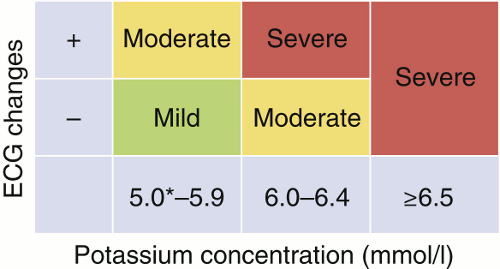European Resuscitation Council[3]Lott C, Truhlář A, Alfonzo A, et al. European Resuscitation Council Guidelines 2021: cardiac arrest in special circumstances. Resuscitation. 2021 Apr;161:152-219.
https://www.doi.org/10.1016/j.resuscitation.2021.02.011
http://www.ncbi.nlm.nih.gov/pubmed/33773826?tool=bestpractice.com
There is no universally accepted definition of hyperkalaemia. However, many guidelines, including the American College of Emergency Physicians hyperkalaemia management in the emergency department expert panel consensus and the UK Kidney Association (formerly the Renal Association) clinical practice guidelines on the treatment of acute hyperkalaemia in adults, use thresholds for serum potassium as defined by the European Resuscitation Council classification of severity of hyperkalaemia:[1]Alfonzo A, Harrison A, Baines R, et al; UK Kidney Association (formerly the Renal Association). Clinical practice guidelines: treatment of acute hyperkalaemia in adults. June 2020 [internet publication].
https://ukkidney.org/sites/renal.org/files/RENAL%20ASSOCIATION%20HYPERKALAEMIA%20GUIDELINE%20-%20JULY%202022%20V2_0.pdf
[2]Rafique Z, Peacock F, Armstead T, et al. Hyperkalemia management in the emergency department: an expert panel consensus. J Am Coll Emerg Physicians Open. 2021 Oct;2(5):e12572.
https://www.doi.org/10.1002/emp2.12572
http://www.ncbi.nlm.nih.gov/pubmed/34632453?tool=bestpractice.com
[3]Lott C, Truhlář A, Alfonzo A, et al. European Resuscitation Council Guidelines 2021: cardiac arrest in special circumstances. Resuscitation. 2021 Apr;161:152-219.
https://www.doi.org/10.1016/j.resuscitation.2021.02.011
http://www.ncbi.nlm.nih.gov/pubmed/33773826?tool=bestpractice.com
Mild hyperkalaemia: 5.5 to 5.9 mmol/L (5.5 to 5.9 mEq/L)
Moderate hyperkalaemia: 6.0 to 6.4 mmol/L (6.0 to 6.4 mEq/L)
Severe hyperkalaemia: ≥6.5 mmol/L (≥6.5 mEq/L).
Investigator Network Initiative Cardiovascular and Renal Clinical Trialists (INI-CRCT)[12]Rossignol P, Legrand M, Kosiborod M, et al. Emergency management of severe hyperkalemia: guideline for best practice and opportunities for the future. Pharmacol Res. 2016 Nov;113(pt a):585-91.
https://www.doi.org/10.1016/j.phrs.2016.09.039
http://www.ncbi.nlm.nih.gov/pubmed/27693804?tool=bestpractice.com
INI-CRCT note that serum potassium levels of >6.0 mmol/L (>6.0 mEq/L) or >6.5 mmol/L (>6.5 mEq/L) or electrocardiogram (ECG) manifestations of hyperkalaemia (regardless of serum potassium level) have been recommended as thresholds for initiation of emergency therapy due to the risk of acute life-threatening cardiac rhythm disorders.
Kidney Disease: Improving Global Outcomes (KDIGO)[4]Clase CM, Carrero JJ, Ellison DH, et al. Potassium homeostasis and management of dyskalemia in kidney diseases: conclusions from a Kidney Disease: Improving Global Outcomes (KDIGO) controversies conference. Kidney Int. 2020 Jan;97(1):42-61.
https://www.doi.org/10.1016/j.kint.2019.09.018
http://www.ncbi.nlm.nih.gov/pubmed/31706619?tool=bestpractice.com
KDIGO suggests classifying hyperkalaemia as mild, moderate, or severe based on the potassium concentration and the presence or absence of ECG changes.
[Figure caption and citation for the preceding image starts]: Severity of acute hyperkalaemia risk classification (KDIGO). *5.0 mmol/L (5.0 mEq/L) or upper limit of normal range. ECG, electrocardiogramClase et al. Kidney Int. 2020;97(1):42-61; used with permission [Citation ends].
